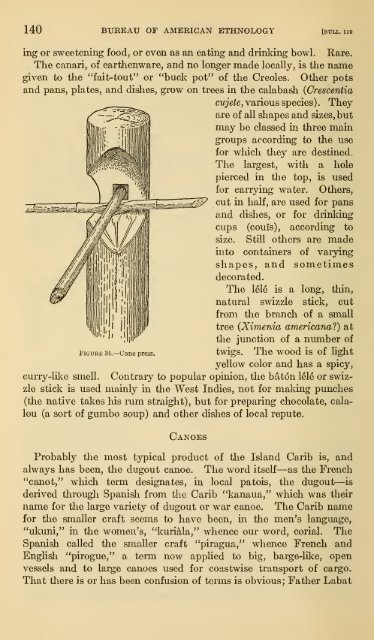You also want an ePaper? Increase the reach of your titles
YUMPU automatically turns print PDFs into web optimized ePapers that Google loves.
140 BUEEAU OF AMERICAN ETHNOLOGY [bull. 119<br />
ing or sweetening food, or even as an eating and drinking bowl.<br />
Rare.<br />
<strong>The</strong> canari, <strong>of</strong> earthenware, and no longer made locally, is the name<br />
given to the "fait-toiit" or "buck pot" <strong>of</strong> the Creoles. Other pots<br />
and pans, plates, and dishes, grow on trees in the calabash (Crescentia<br />
Figure 34.—Cane press.<br />
cujete, various species) . <strong>The</strong>y<br />
are <strong>of</strong> all shapes and sizes, but<br />
may be classed in three main<br />
groups according to the use<br />
for which they are destined.<br />
<strong>The</strong> largest, with a hole<br />
pierced in the top, is used<br />
for canying water. Others,<br />
cut in half, are used for pans<br />
and dishes, or for drinldng<br />
cups (couis), according to<br />
size. Still others are made<br />
into containers <strong>of</strong> varying<br />
shapes, and sometimes<br />
decorated.<br />
<strong>The</strong> lele is a long, thin,<br />
natural swizzle stick, cut<br />
from the branch <strong>of</strong> a small<br />
tree (Ximenia americanal) at<br />
the<br />
junction <strong>of</strong> a number <strong>of</strong><br />
twigs. <strong>The</strong> wood is <strong>of</strong> light<br />
yellow color and has a spicy,<br />
curry-like smell. Contrary to popular opinion, the bat6n lele or swizzle<br />
stick is used mainly in the West Indies, not for making punches<br />
(the native takes his rum straight), but for preparing chocolate, calalou<br />
(a sort <strong>of</strong> gumbo soup) and other dishes <strong>of</strong> local repute.<br />
Canoes<br />
Probably the most typical product <strong>of</strong> the Island Carib is, and<br />
always has been, the dugout canoe. <strong>The</strong> word itself—as the French<br />
"canot," which term designates, in local patois, the dugout—is<br />
derived through Spanish from the Carib "kanaua," which was their<br />
name for the large variety <strong>of</strong> dugout or war canoe. <strong>The</strong> Carib name<br />
for the smaller craft seems to have been, in the men's language,<br />
"ukuni," in the women's, "kuriala," whence our word, corial. <strong>The</strong><br />
Spanish called the smaller craft "piragua," whence French and<br />
English "pirogue," a term now applied to big, barge-hke, open<br />
vessels and to large canoes used for coastwise transport <strong>of</strong> cargo.<br />
That there is or has been confusion <strong>of</strong> terms is obvious; Father Labat

















